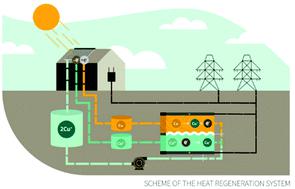当前位置:
X-MOL 学术
›
Energy Environ. Sci.
›
论文详情
Our official English website, www.x-mol.net, welcomes your
feedback! (Note: you will need to create a separate account there.)
Thermally regenerative copper nanoslurry flow batteries for heat-to-power conversion with low-grade thermal energy
Energy & Environmental Science ( IF 32.4 ) Pub Date : 2020-06-09 , DOI: 10.1039/d0ee01590c Sunny Maye 1, 2, 3, 4, 5 , Hubert H. Girault 1, 2, 3, 4, 5 , Pekka Peljo 1, 2, 3, 4, 5
Energy & Environmental Science ( IF 32.4 ) Pub Date : 2020-06-09 , DOI: 10.1039/d0ee01590c Sunny Maye 1, 2, 3, 4, 5 , Hubert H. Girault 1, 2, 3, 4, 5 , Pekka Peljo 1, 2, 3, 4, 5
Affiliation

|
Low-grade heat (below 200 °C) is available in vast quantities from industry, or from standard roof-top solar thermal collectors. However, the production of electric power from these heat sources is challenging with existing technologies. Thermally regenerative batteries allow both the conversion and the storage of thermal energy into electric power, but they suffer from low operation voltages and low output power. Here, we propose a thermally regenerative nanoslurry flow battery based on copper complexation with acetonitrile in non-aqueous solutions operating at voltages above 1 V. The Cu(I) complex can be destabilized by the removal of acetonitrile by distillation, leading to the production of solid copper nanoparticles and Cu(II) in solution, thereby charging the battery. We demonstrate the electricity production at average power densities of 90 W m−2 and peak-power densities up to 150 W m−2, and estimate the theoretical efficiency of the full system at 2%. The results demonstrate a proof-of-concept for harvesting and storage of electricity from low-quality heat.
中文翻译:

用于低热能热能转换的蓄热铜纳米浆料液流电池
工业或标准屋顶太阳能集热器可大量提供低等级热量(低于200°C)。然而,利用现有技术从这些热源产生电力是具有挑战性的。蓄热式电池既可以将热能转换又可以将电能存储为电能,但是它们的工作电压低,输出功率低。在这里,我们提出了一种热再生纳米浆料液流电池,该电池基于铜与乙腈在电压高于1 V的非水溶液中的络合作用。Cu(I)络合物可通过蒸馏除去乙腈而不稳定,从而导致生产固态铜纳米颗粒和Cu(II)溶液中,从而为电池充电。我们证明了平均功率密度为90 W m -2且峰值功率密度高达150 W m -2时的发电量,并估计整个系统的理论效率为2%。结果证明了从劣质热中收集和储存电能的概念证明。
更新日期:2020-07-15
中文翻译:

用于低热能热能转换的蓄热铜纳米浆料液流电池
工业或标准屋顶太阳能集热器可大量提供低等级热量(低于200°C)。然而,利用现有技术从这些热源产生电力是具有挑战性的。蓄热式电池既可以将热能转换又可以将电能存储为电能,但是它们的工作电压低,输出功率低。在这里,我们提出了一种热再生纳米浆料液流电池,该电池基于铜与乙腈在电压高于1 V的非水溶液中的络合作用。Cu(I)络合物可通过蒸馏除去乙腈而不稳定,从而导致生产固态铜纳米颗粒和Cu(II)溶液中,从而为电池充电。我们证明了平均功率密度为90 W m -2且峰值功率密度高达150 W m -2时的发电量,并估计整个系统的理论效率为2%。结果证明了从劣质热中收集和储存电能的概念证明。











































 京公网安备 11010802027423号
京公网安备 11010802027423号